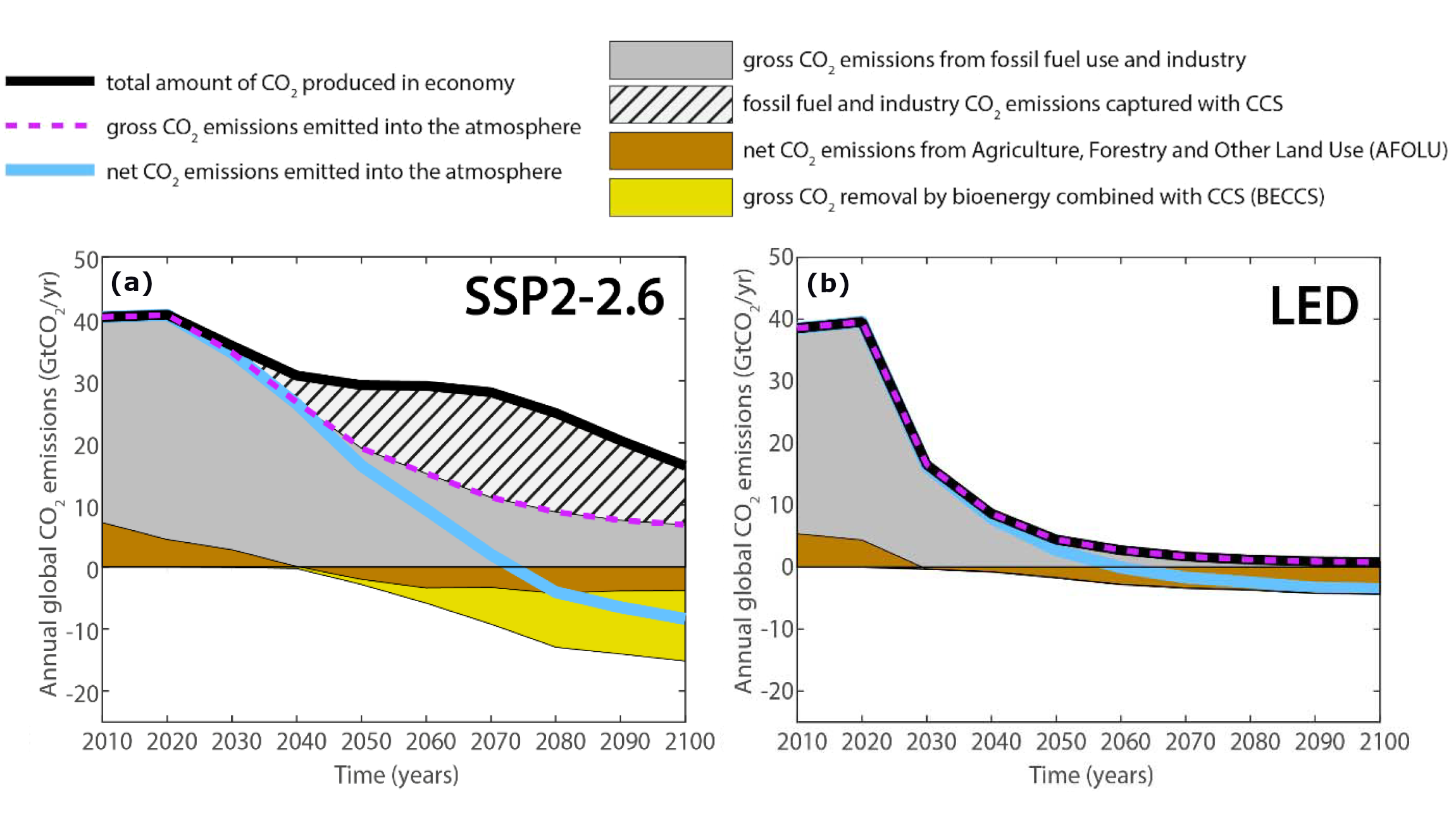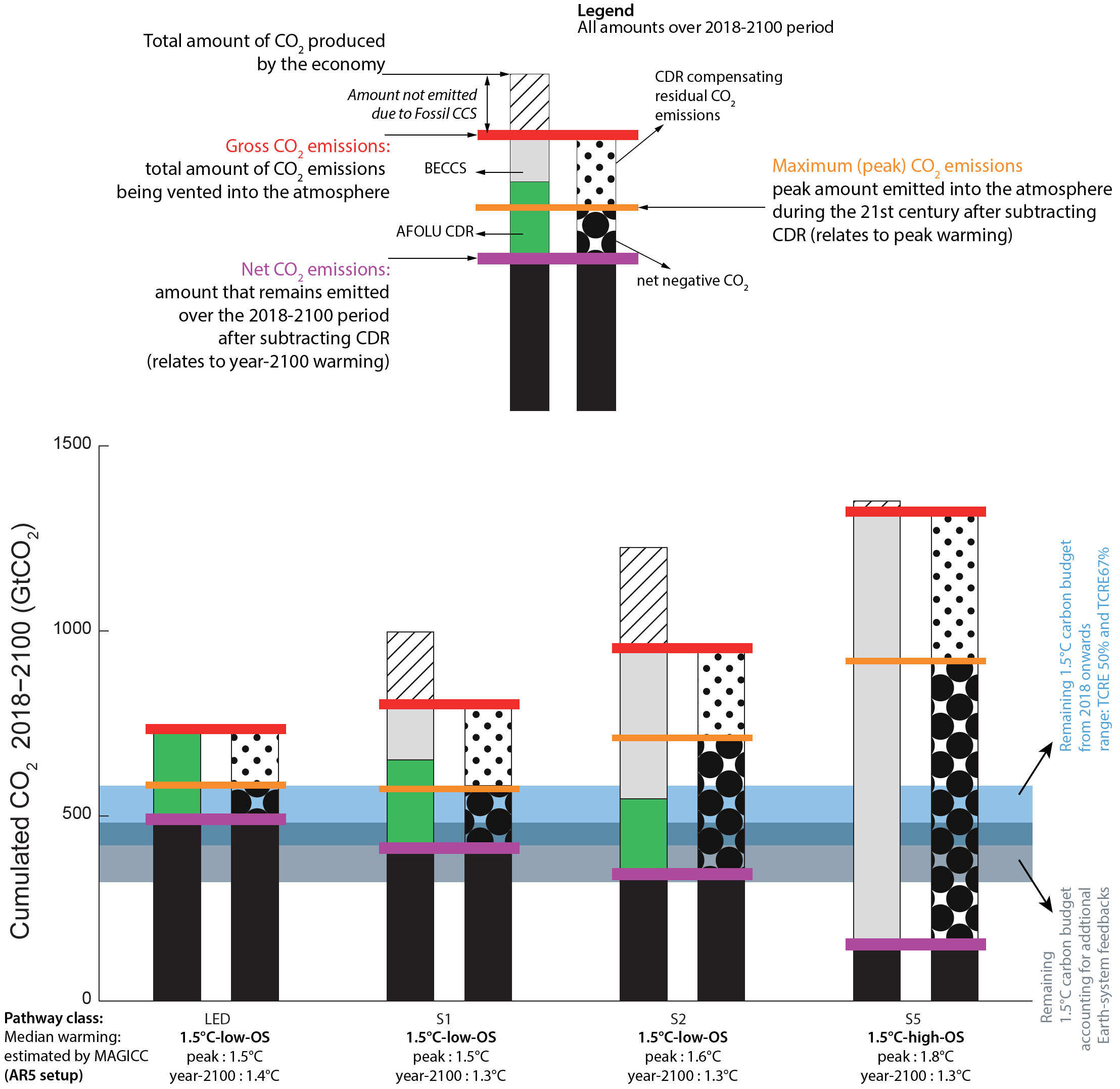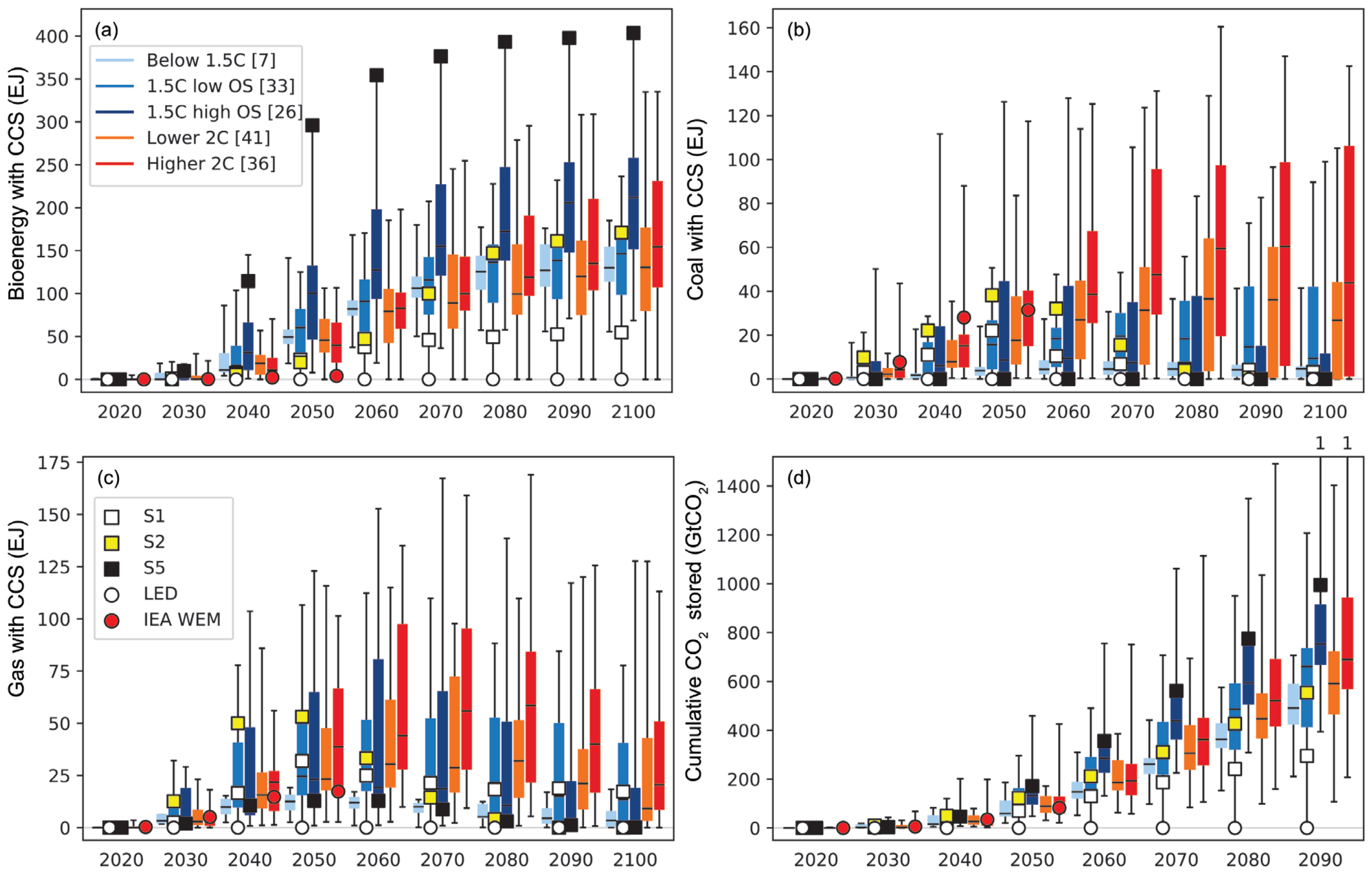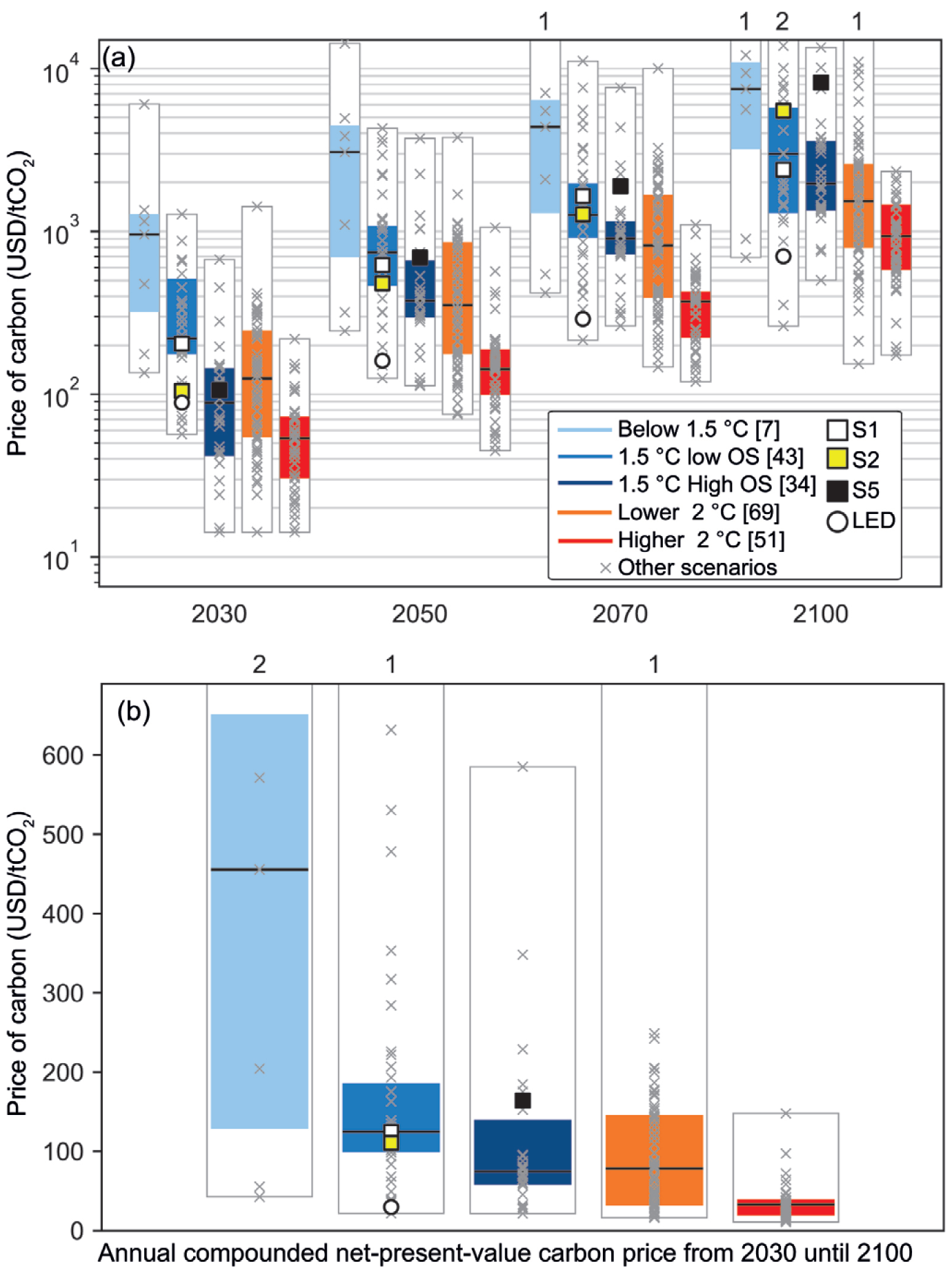Two very different visions of decarbonisation:
(a) Fossil-fueled development, high energy demand, heavy reliance on CCS and BECCS9
(b) Leave fossil-fuels in the ground, low energy demand (LED), no CCS or BECCS
‘(a)’ and ‘(b)’ are at opposite extremes in a sense. ‘b’ is considered radical, and mainstream scenarios are, of course, closer to ‘a’ than ‘b’.Image: Grubler – Presentation on a Low Energy Demand scenario10 Figure rearranged and relabelled.
Table of Contents
Summary
- The IPCC’s Shared Socio-Economic Pathways (SSPs) cover a range of future scenarios. The SSP1-based ‘sustainability’ (or ‘green growth’) scenarios that stay within 2°C of warming above the pre-industrial level, rely on ‘negative emissions’ and BECCS9 (eg. see the figure below for global primary energy mix, SSP1, and 2.6 W/m2 climate forcing).
- The IPCC’s 1.5°C scenarios in their recent ‘special report’ are unusually ambitious. Many commentators have given up on the possibility of remaining anywhere near 1.5°C of warming above pre-industrial levels, but, for a brief window of time these experts have seriously considered how it might be achieved. For primary energy, we see a strong reliance on BECCS in the second half of the century (in the ‘middle of the road’ (S2) scenario, and in the ‘fossil-fuel intensive’ (S5) scenario). Primary energy is also projected to be increasingly sourced from renewable energy and nuclear power. In the IPCC’s 1.5°C scenarios, electricity is sourced mainly from renewables in the second half of the century, along with an increase in nuclear power. While BECCS is projected to be an important tool for decarbonising total primary energy, it has limited application in decarbonising electricity in these IPCC scenarios.
Shared Socio-Economic Pathways (SSPs)
(This section hasn’t been written. The figures and tables might be used later)Summary of SSP narratives
Source: Riahi et al (2017)1, Table 2
SSP1 Sustainability – Taking the Green Road (Low challenges to mitigation and adaptation)
“The world shifts gradually, but pervasively, toward a more sustainable path, emphasizing more inclusive development that respects perceived environmental boundaries. Management of the global commons slowly improves, educational and health investments accelerate the demographic transition, and the emphasis on economic growth shifts toward a broader emphasis on human well-being. Driven by an increasing commitment to achieving development goals, inequality is reduced both across and within countries. Consumption is oriented toward low material growth and lower resource and energy intensity.”SSP2 Middle of the Road (Medium challenges to mitigation and adaptation)
“The world follows a path in which social, economic, and technological trends do not shift markedly from historical patterns. Development and income growth proceeds unevenly, with some countries making relatively good progress while others fall short of expectations. Global and national institutions work toward but make slow progress in achieving sustainable development goals. Environmental systems experience degradation, although there are some improvements and overall the intensity of resource and energy use declines. Global population growth is moderate and levels off in the second half of the century. Income inequality persists or improves only slowly and challenges to reducing vulnerability to societal and environmental changes remain.”SSP3 Regional Rivalry – A Rocky Road (High challenges to mitigation and adaptation)
“A resurgent nationalism, concerns about competitiveness and security, and regional conflicts push countries to increasingly focus on domestic or, at most, regional issues. Policies shift over time to become increasingly oriented toward national and regional security issues. Countries focus on achieving energy and food security goals within their own regions at the expense of broader-based development. Investments in education and technological development decline. Economic development is slow, consumption is material-intensive, and inequalities persist or worsen over time. Population growth is low in industrialized and high in developing countries. A low international priority for addressing environmental concerns leads to strong environmental degradation in some regions.”SSP4 Inequality – A Road Divided (Low challenges to mitigation, high challenges to adaptation)
“Highly unequal investments in human capital, combined with increasing disparities in economic opportunity and political power, lead to increasing inequalities and stratification both across and within countries. Over time, a gap widens between an internationally-connected society that contributes to knowledge- and capital-intensive sectors of the global economy, and a fragmented collection of lower-income, poorly educated societies that work in a labor intensive, low-tech economy. Social cohesion degrades and conflict and unrest become increasingly common. Technology development is high in the high-tech economy and sectors. The globally connected energy sector diversifies, with investments in both carbon-intensive fuels like coal and unconventional oil, but also low-carbon energy sources. Environmental policies focus on local issues around middle and high income areas.”SSP5 Fossil-fueled Development – Taking the Highway (High challenges to mitigation, low challenges to adaptation)
“This world places increasing faith in competitive markets, innovation and participatory societies to produce rapid technological progress and development of human capital as the path to sustainable development. Global markets are increasingly integrated. There are also strong investments in health, education, and institutions to enhance human and social capital. At the same time, the push for economic and social development is coupled with the exploitation of abundant fossil fuel resources and the adoption of resource and energy intensive lifestyles around the world. All these factors lead to rapid growth of the global economy, while global population peaks and declines in the 21st century. Local environmental problems like air pollution are successfully managed. There is faith in the ability to effectively manage social and ecological systems, including by geo-engineering if necessary.”Source: Riahi et al (2017)1, Table 2
Key Characteristics of the Five Shared Socio-Economic Pathways (SSPs)

Source: IPCC (2018) SR15 4, Table 2.3
Overview of basic Shared Socio-Economic Pathways (SSPs) and the energy sector elements of the narratives

Source: Bauer et al (2017)2, Fig. 1
Global CO2 emissions from fossil fuels and industry
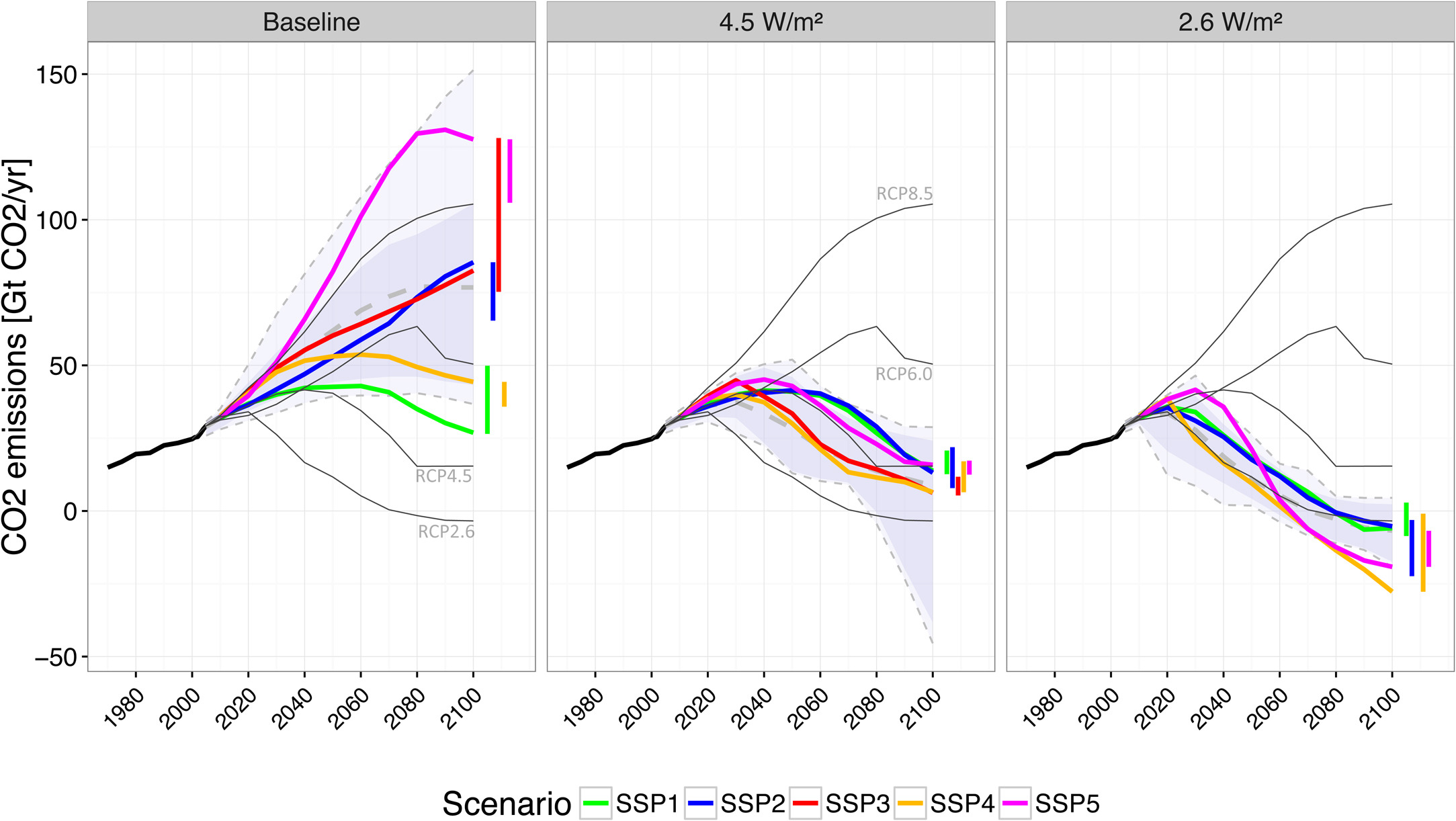
Source: Bauer et al (2017)2, Fig. 8
Emissions over time for SSP1 (‘Green growth’) reference scenario, 4.5, 2.6 W/m2

Source: van Vuuren et al (2017)6, Fig. 14
CO2 emissions from fossil fuels and industry by region

Source: Bauer et al (2017)3, Fig. S8
World regions in the image above: OECD countries (OECD), the countries from ‘reforming economies of Eastern Europe and the former Soviet Union’ (REF), Latin America (LAM), Asia (ASIA), MAF (Middle East and Africa).CO2 emissions for energy by sector

Source: Bauer et al (2017)3, Fig. S9
Global primary energy mix across SSPs and climate policy cases

Source: Bauer et al (2017)2, Fig. 5a
Fossil fuel shares of primary energy
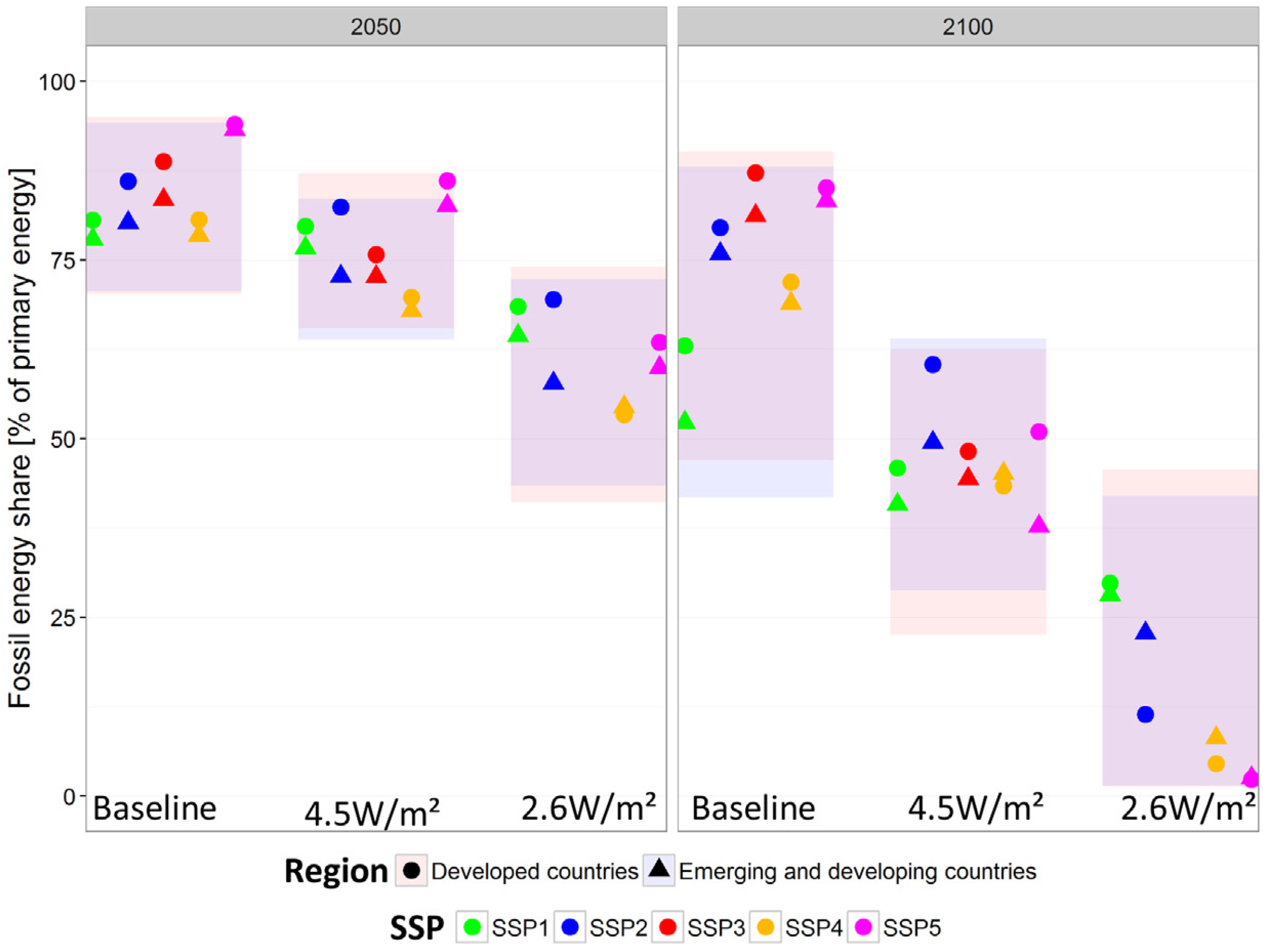
Source: Bauer et al (2017)2, Fig. 5b
In the article they denote ‘developed’ countries as OECD countries (OECD) and the countries from ‘reforming economies of Eastern Europe and the former Soviet Union’ (REF), and ‘emerging and developing’ regions as Latin America (LAM), Asia (ASIA), MAF (Middle East and Africa).Global final energy mix across SSPs and climate stabilisation cases
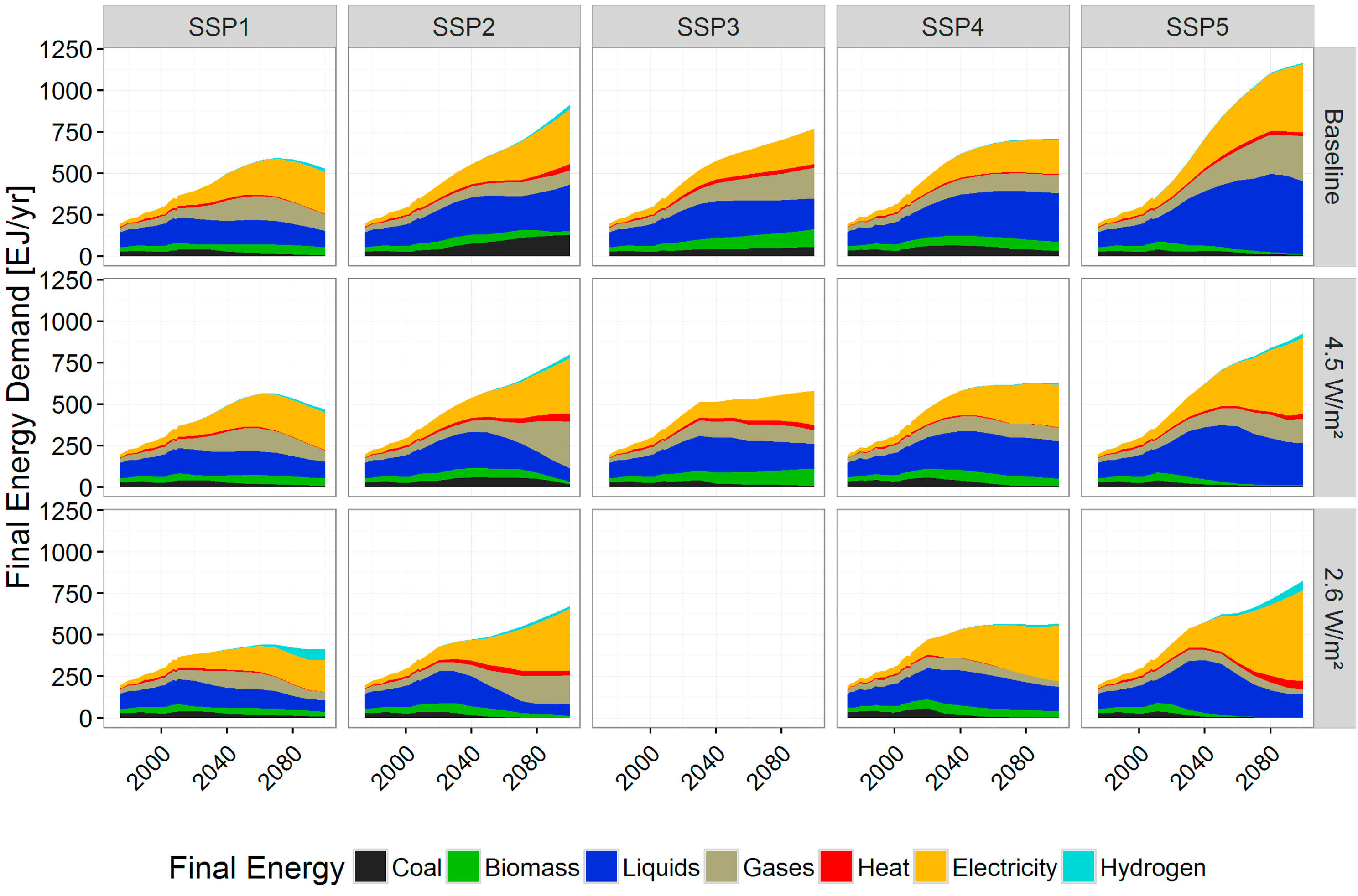
Source: Bauer et al (2017)2, Fig. 4a
Development of regional final energy use per capita GDP (PPP)
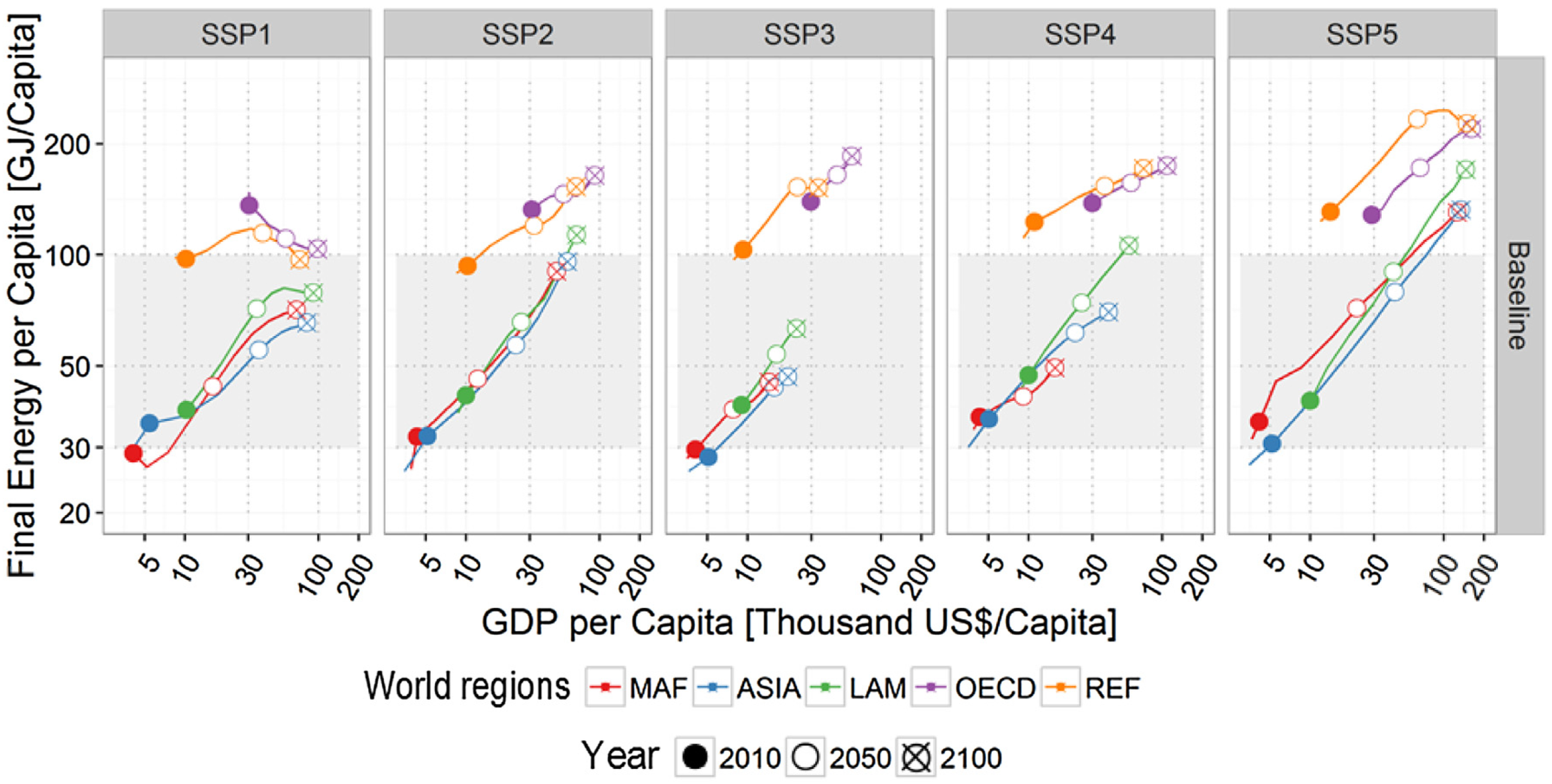
Source: Bauer et al (2017)2, Fig. 3a
Where GDP (PPP) is Gross Domestic Product (Purchasing Power Parity). As mentioned above, in the article they denote ‘developed’ countries as OECD countries (OECD) and the countries from ‘reforming economies of Eastern Europe and the former Soviet Union’ (REF), and ‘emerging and developing’ regions as Latin America (LAM), Asia (ASIA), MAF (Middle East and Africa).Final energy use per capita in the ‘developed’ and ’emerging and developing’ countries

Source: Bauer et al (2017)2, Fig. 3b
Electricity share of final energy use in ‘developed’ countries and ’emerging and developing’ countries

Source: Bauer et al (2017)2, Fig. 4b
Where “Electricity accounts for the consumption of final electricity consumers and does not include losses for transmission and distribution.”Global power generation by technology differentiated by SSPs and policy scenario

Source: Bauer et al (2017)2, Fig. 7
Global transport sector energy demand mix across SSPs and climate policy cases

Source: Bauer et al (2017)3, Fig. S13
Global production mix of liquid fuels by technology and primary energy source

Source: Bauer et al (2017)3, Fig. S14
Global mix of bio-fuel production from bio-energy differentiated by secondary energy carrier

Source: Bauer et al (2017)3, Fig. S15
Low energy demand (LED) scenario
(This section hasn’t been written. The figures and tables might be used later)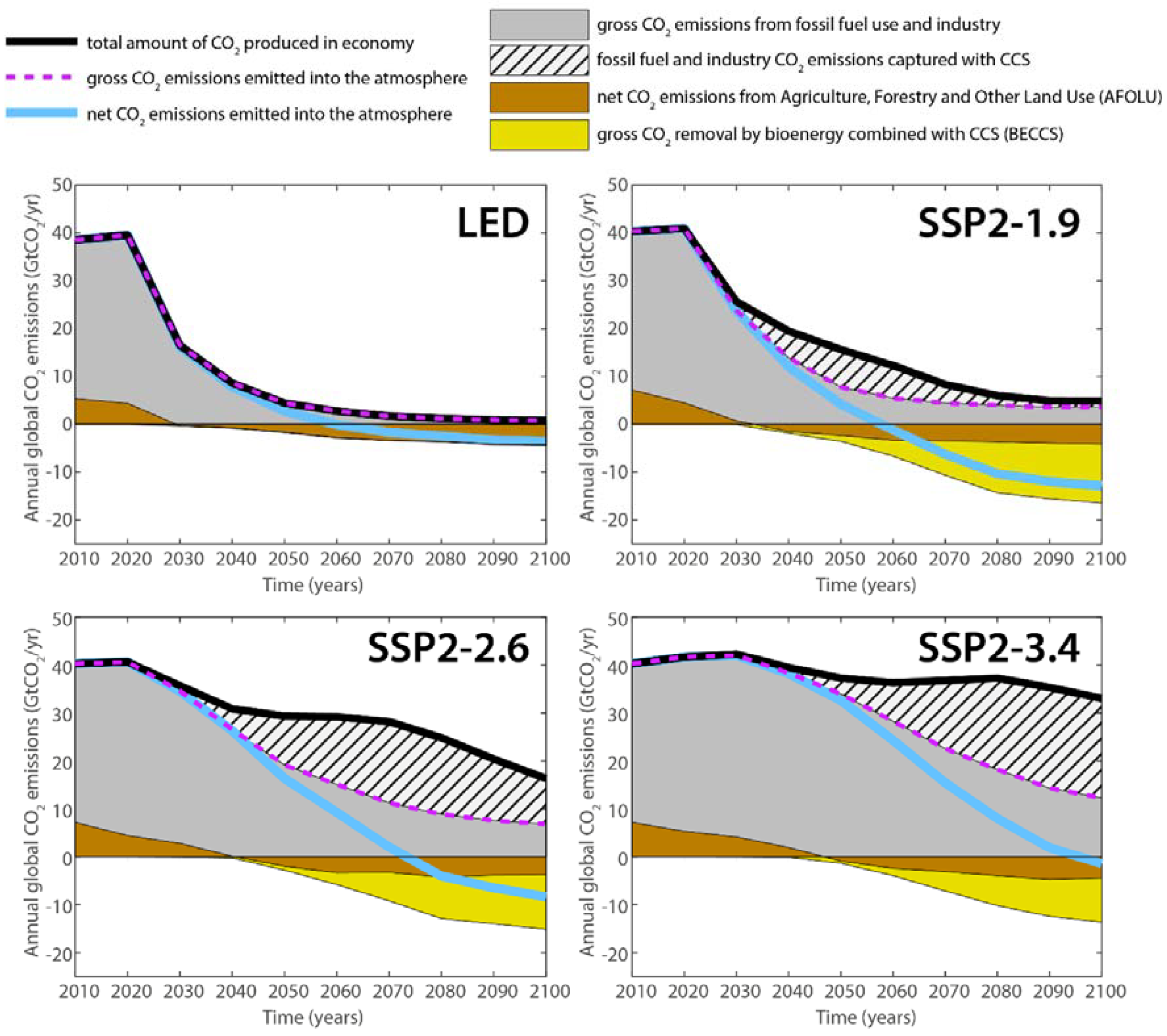
Source: Grubler et al (2018)8, Supplementary Fig. 17
1.5°C scenarios from the IPCC
(This section hasn’t been written. The figures and tables might be used later)Cumulative CO2 emissions for the four 1.5°C-consistent pathway archetypes
Source: IPCC (2018) SR154, Fig. 2.10 (rearranged)
‘High OS’ involves overshooting 1.5°C and stabilisation at a later stage, and ‘low OS’ is ‘low overshoot’.Evolution and break down of global anthropogenic CO2 emissions until 2100

Source: IPCC (2018) SR154, Fig. 2.5
“Note that the S5 scenario reports the building and industry sector emissions jointly. Green-blue areas hence show emissions from the transport sector and the joint building and industry demand sector, respectively.”Source: IPCC (2018) SR154, Fig. 2.5
Breakdown of contributions to global net CO2 emissions in four illustrative model pathways

Source: IPCC (2018) SR155, Fig. SPM.3b
The four scenarios above (P1, P2, P3, P4) correspond to the four scenarios (LED, S1, S2, S5)- P1 : LED – Low energy demand scenario
- P2 : S1 – Sustainability (SSP1)
- P3 : S2 – Middle of the road (SSP2)
- P4 : S5 – Fossil-fuel intensive (SSP5)
Cumulative CDR deployment in 1.5°C-consistent pathways in the literature until 2050 and 2100
Source: IPCC (2018) SR154, Fig. 2.9
Land-use changes in 2050 and 2100 in the illustrative 1.5°C-consistent pathway archetypes
Source: IPCC (2018) SR154, Fig. 2.11
Electricity and primary energy: limiting warming to 1.5°C with no or limited overshoot

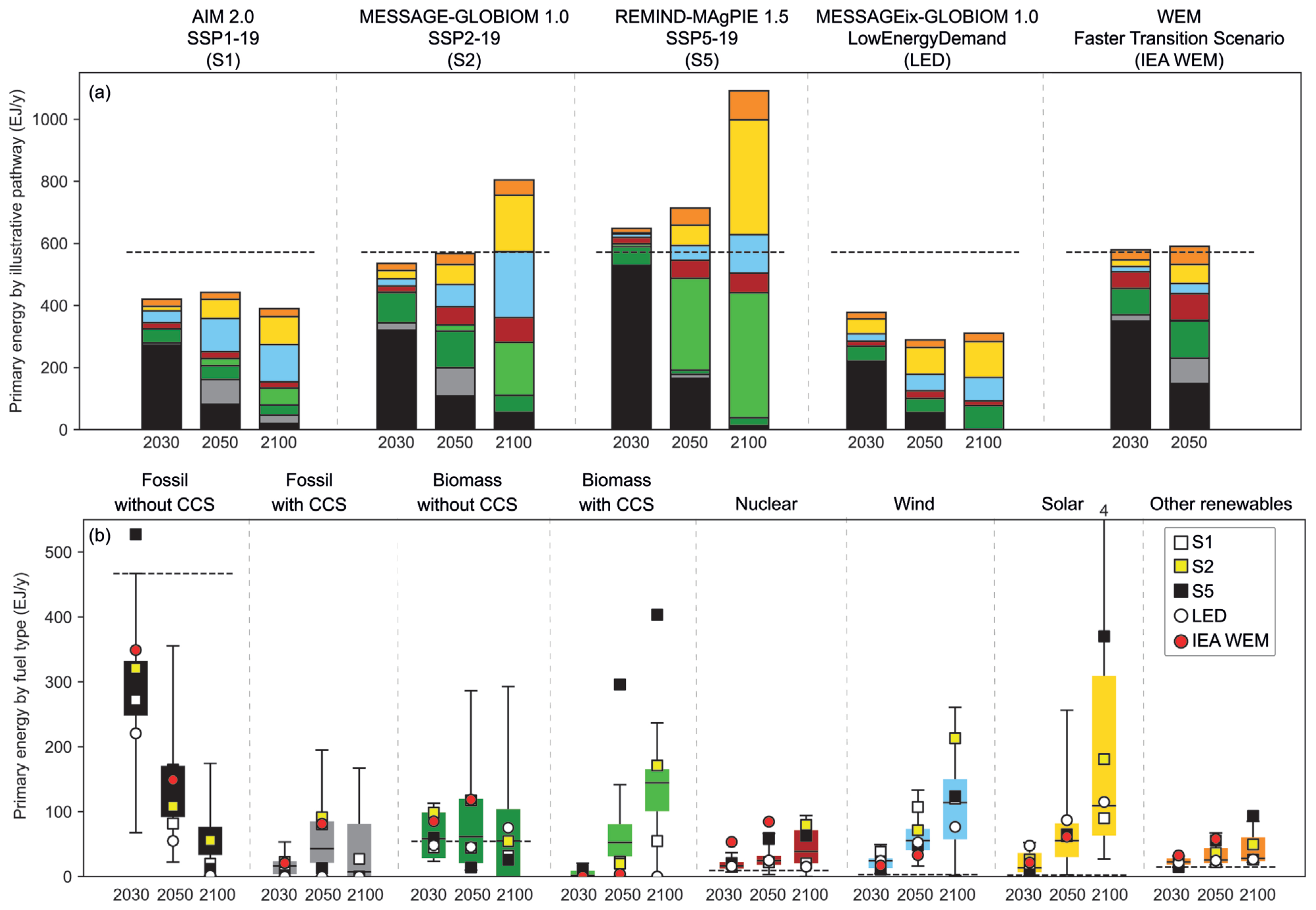
Source: IPCC (2018) SR154, Fig. 2.15 & Fig. 2.16
CCS deployment in 1.5°C and 2°C pathways for (a) BECCS (b) coal with CCS (c) gas with CCS (d) cumulative CO2 stored via CCS
Source: IPCC (2018) SR154, Fig. 2.17
Global price of carbon emissions consistent with mitigation pathways
Source: IPCC (2018) SR154, Fig. 2.26

- Riahi et al (2017) The Shared Socioeconomic Pathways and their energy, land use, and greenhouse gas emissions implications: An overview
- Bauer et al (2017) Shared Socio-Economic Pathways of the Energy Sector – Quantifying the Narratives
- Bauer et al (2017) Shared Socio-Economic Pathways of the Energy Sector – Quantifying the Narratives, Supporting online material
- IPCC (2018) Special Report: Global Warming of 1.5°C
- IPCC (2018) Special Report: Global Warming of 1.5°C – Summary for Policymakers
- van Vuuren et al (2017) Energy, land-use and greenhouse gas emissions trajectories under a green growth paradigm
- Grubler et al (2018) A low energy demand scenario for meeting the 1.5 °C target and sustainable development goals without negative emission technologies
- Grubler et al (2018) A low energy demand scenario for meeting the 1.5 °C target and sustainable development goals without negative emission technologies – Supplementary information
- Carbon Brief (2016) Timeline: How BECCS became climate change’s ‘saviour’ technology
- A presentation by Arnulf Grubler on a Low Energy Demand scenario (PDF)
